Many thanks to SWLing Post contributor Dan Robinson who shares this fascinating story about what has to be “one of the most important occurrences involving a SWBC station that no longer exists — the Voice of Biafra”:
Biafra: One of the rarest of SWBC QSLs
by Dan Robinson
Many SWLing Post readers will no doubt have heard, in recent years, the station Radio Biafra broadcasting via various relay locations on shortwave, and also on the Internet.
Those of us who have been SWLs for many decades remember the history of Biafra and the story of the original Voice of Biafra, which when the station was active on shortwave, before it was closed down by Nigerian government forces.
My own SWLing career began in the late 1960’s, but alas my receivers at the time, and my knowledge of what was on the air were such that I did not hear the transmissions from Biafra (I’m one of those who regrets having missed many former tropical band broadcasters, such as Tonga, Fiji, Gilbert & Ellice Islands (later known as Kiribati) when they used shortwave, and Biafra was on that list as well).
I first learned about the original Radio Biafra from articles written by the late Don Jensen.
In one of those [download PDF], Don re-printed a copy of one of the most famous SWBC QSLs of all time — a Biafra verification sent to DX’er Alan Roth.
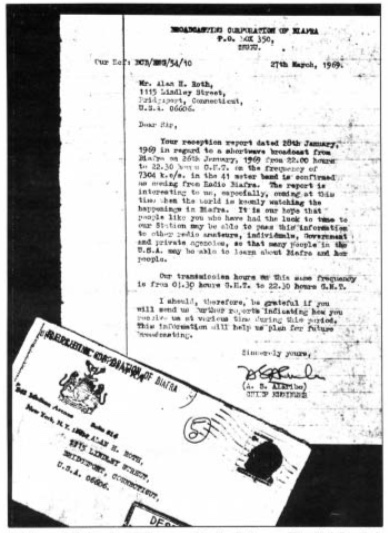 Typed on a piece of notebook paper, it had “Broadcasting Corporation of Biafra, P.O. Box 350, Enugu” at the top. Three paragraphs of text followed, referring to Roth’s reception dated January 28th, 1969 of the station on 7,304 kHz.
Typed on a piece of notebook paper, it had “Broadcasting Corporation of Biafra, P.O. Box 350, Enugu” at the top. Three paragraphs of text followed, referring to Roth’s reception dated January 28th, 1969 of the station on 7,304 kHz.
Pictured with the letter to Roth was the envelope with “Republic of Biafra” mailed from the Biafra mission on Madison Avenue, in New York City. I will always remember the caption, which said that Roth had taken his reception report to the Biafran delegation office which:
“managed to get it flown into the breakaway nation with other official correspondence, on the emergency airlift. Radio Biafra’s chief engineer wrote the verification letter and returned it via the same route. . . a high contrast photo was required to bring out the typing since a well-born typewriter ribbon had been used.”
For decades this Biafra verification to Roth was indeed considered to be the only one in existence, though because so many SWLs and DX’ers were active through the years, it’s always difficult to state this with certainty.
Those of us who collect historic SWBC QSLs, going through thousands of eBay listings, always keep an eye out for cards and letters and station materials.
So it was that a few weeks ago, as I was doing my usual due diligence looking through eBay listings, I noticed something unusual. Listed among SWBC QSLs from a seller in Ithaca, New York was something astounding — another Biafra verification letter!
Looking closely, it seemed to be exactly like the famous QSL letter sent to Alan Roth in 1969, with the exact same date, but sent to a James G. Moffitt, in Dallas, Texas.
Days ticked by — I had the QSL on ‘watch’ status on my eBay account, and as I do for any QSL of high value, I also had it on automatic bid status. For this piece of SWBC history, my maximum bid was very high, something I rarely do unless the item has extreme historic or collectors significance.
I envisioned furious bidding for this Biafra verification, but in the end only four bids were recorded. I won the QSL at what I consider to be a very low price ($81) considering its rarity.
Now, the rest of the story.
It turns out that among the three other bidders was none other than Jerry Berg, DX’ing colleague and author of so many wonderful books on the history of shortwave.
As I was preparing to complete this story for SWLing Post, I emailed Jerry who had already written up a comprehensive story about this newly-discovered Biafra verification.
Jerry’s superb article also includes links to the late Don Jensen pieces (The Life and Death of Radio Biafra and Biafra’s Incredible Radio), as well as a link to a recording of Voice of Biafra made by one of the other big names in the hobby, Al Sizer:
The “Undiscovered QSL of Radio Biafra”, as Jerry calls it in his new article, now resides with me here in Maryland. Unless/until another of its kind emerges somewhere on the QSL market, it has to be considered the only one of its kind in the world.
As for the question of whether this previously “undiscovered” QSL is genuine, Jerry notes the similarities between the Roth QSL letter from 1969, and the one sent to James G. Moffitt, who he notes was active as a DX’er in the days when Radio Biafra existed.
Jerry continues:
“. . .what about the common date, and date-time-frequency details, in the two veries? If the reports had arrived in Biafra at roughly the same time, it would not be unusual for the replies to be prepared on the same day. As to the common date-time-frequency details, perhaps whoever typed the letters thought these references were standard boilerplate rather than information that was to be tailored to the specific listener. Certainly the frequency could be expected to be the same. The common date of reception is harder to explain, but it is not difficult to see how the almost inevitable difference in dates of reception could have been overlooked. QSLers know that verifications can be wrong in their details, misdated, even sent to the wrong listener. As for the different fonts, and for Alan’s letter being light in appearance and Moffitt’s dark, perhaps the typist changed typewriters because one was running out of ink. We will likely never know for sure, but I think the Moffitt verie (which sold on eBay for $81) is genuine. In any event, the story reminds us how, in every endeavor, even shortwave listening, today’s connected world can cast new light on old events and turn longstanding certainties into question marks.”
I am quite happy with having acquired what surely is one of the rarest of SWBC QSLs. It has been added to a collection that, in addition to my own QSLs that I carefully kept over the years, includes other unique cards, including one from ZOE Tristan da Cunha and the station at the former Portuguese Macao.
Amazing story, Dan! It pleases me to no end to know that someone who values our shortwave radio history–and does a proper job archiving it–has acquired this amazing piece. I especially appreciate the time that you and Jerry Berg put into sharing the history of the Voice of Biafra with the shortwave listening and DXing communities. Thank you!
Readers: As Dan suggests, I strongly encourage you to check out Jerry’s website, On The Shortwaves. It’s a deep treasure trove of radio history.

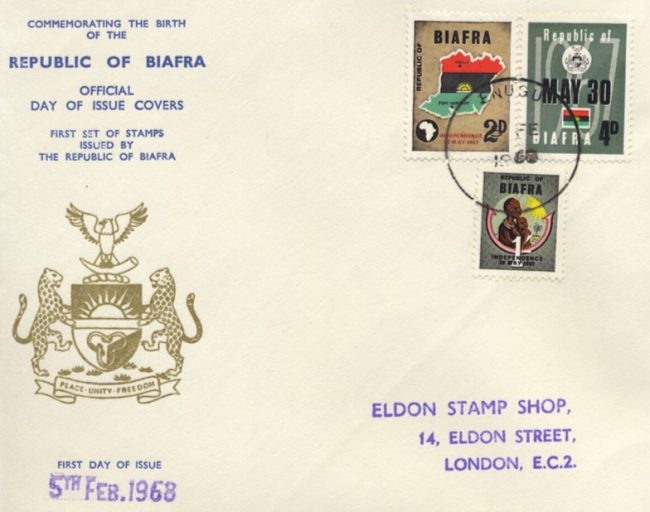
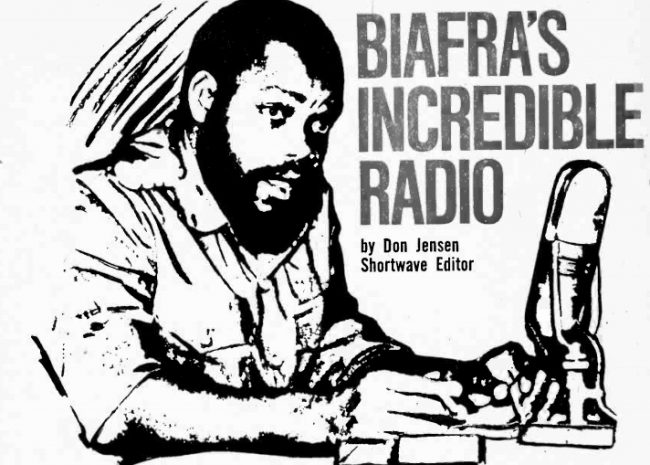
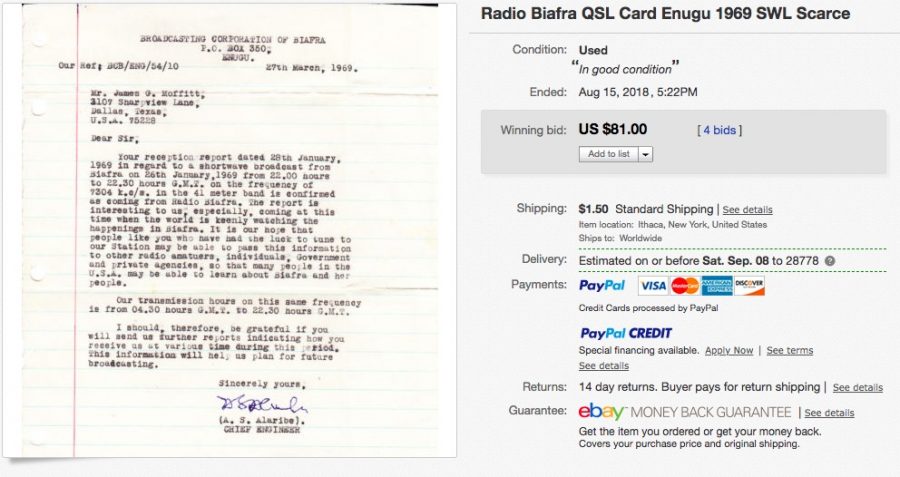
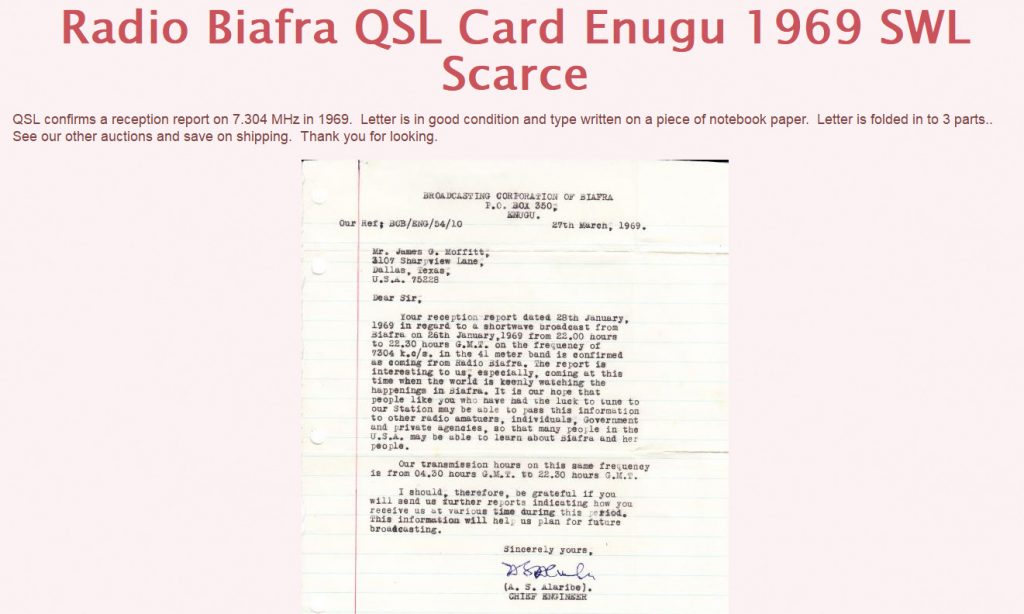
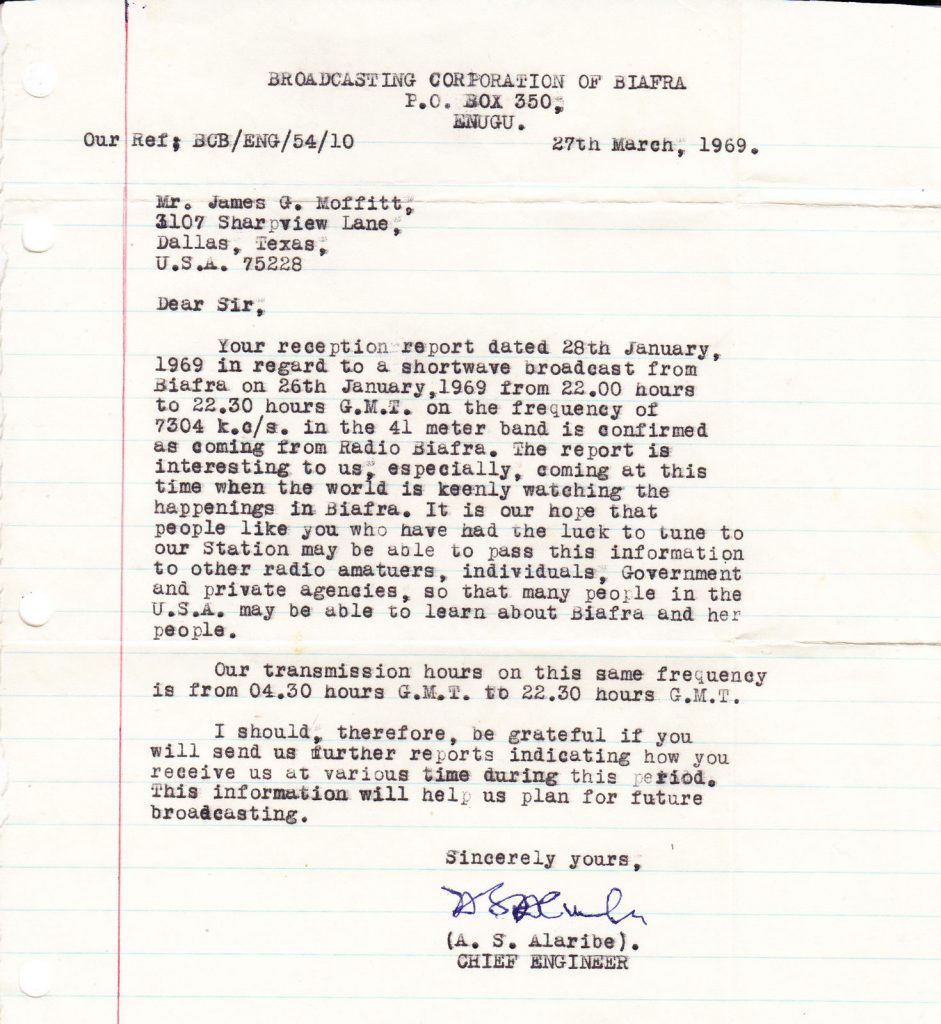
I have some new information I’ll pass on to everyone about the recipient of this Biafra QSL . . . stay tuned!
What a fascinating story. I would tend to think that the newer QSL is real, only because it seems odd to me to forge a verification report. Maybe people did back then for bragging rights, who knows, but it seems to me more trouble than the worth. I guess it is possible though that the latter report was faked but if so why would they use the exact time/date of reception from the original? Makes no sense.
I did get a kick listening to the taped correspondence between the DX’ers. What a fascinating look back into shortwave history and what the hobby was like back then. They didn’t know how lucky they were then and it sounded like they couldn’t even keep up with all of the new stations appearing so frequently.
Thanks — yes, I plan to take closer looks at both and perhaps further information can be obtained
Thank you for providing the history and the story behind this, it is very interesting.
I hope I won’t be flamed for this but I would suggest having the documents looked at by a forensic document specialist. I know the scans aren’t the clearest things in the world but I found myself trying to determine if the notebook paper looked identical and things like that. It’s really very difficult to tell. I also found it odd that the reference number was identical. The signatures are what stick out to me. On the Roth letter the signature is really smoothly written. The loops in the writing are continuous and smooth. The “A” of Alaribe is a thing of art on the Roth letter and a bit of a mess on the Moffitt letter. The signature on the Moffitt letter seems much more shaky, not nearly as smooth.
Don’t get me wrong, I would really love for you to have an authentic piece of history like this. I’m just not sure that they are a true match.
I hope that this comment won’t take away from the story about Radio Biafra.